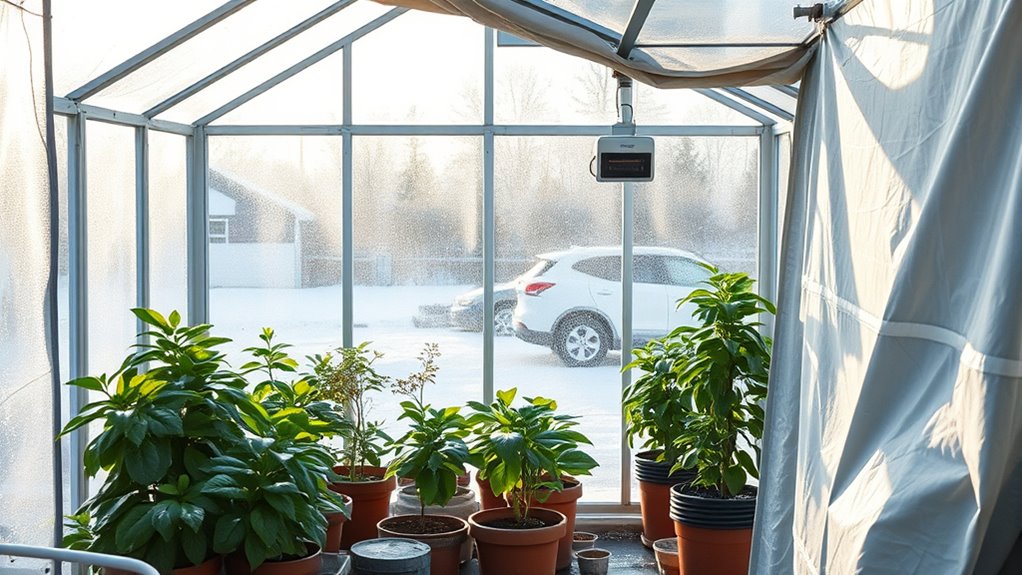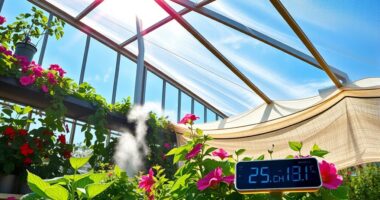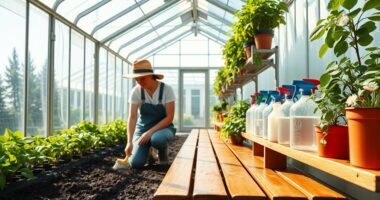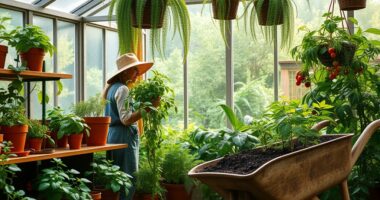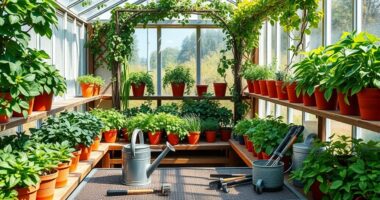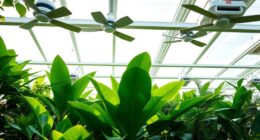To winterize your greenhouse, start by sealing gaps and adding insulation to protect your plants from the cold. Install vent openings or adjustable louvers to control airflow, opening them during warm days to release moisture and closing at night to trap heat. Adjust watering routines to prevent excess moisture and mold, and consider using heaters if necessary. Regularly monitor temperature and humidity levels to fine-tune your environment. Keep these strategies in mind to guarantee your plants stay healthy all winter long.
Key Takeaways
- Install adjustable vents to control airflow and prevent condensation during cold months.
- Insulate vulnerable areas and use heaters to maintain consistent internal temperatures.
- Adjust watering schedules to avoid overwatering and mold growth in lower temperatures.
- Monitor humidity levels regularly with hygrometers to prevent excess moisture and fungal issues.
- Combine ventilation, insulation, and environmental controls for comprehensive winter protection.
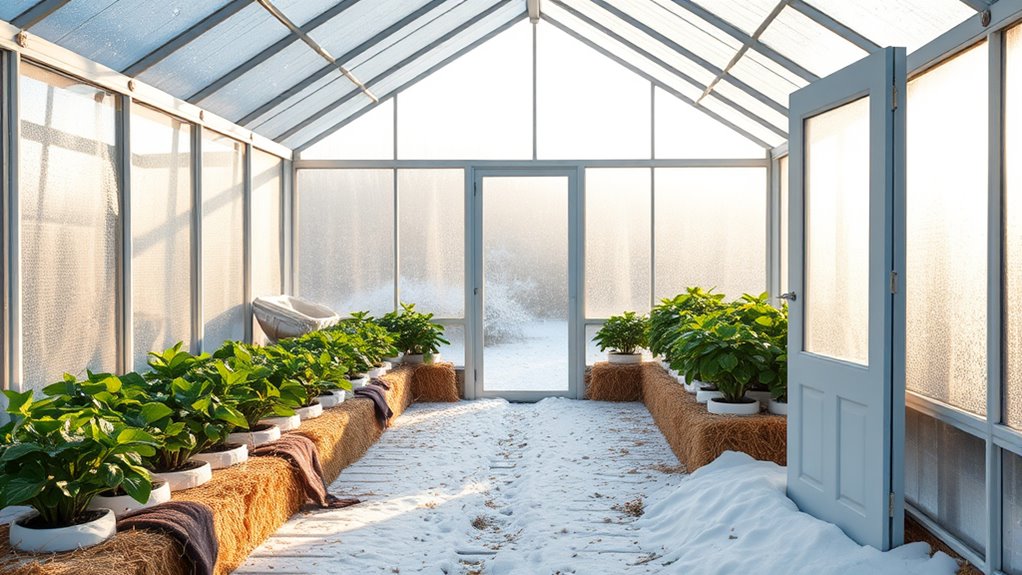
As winter approaches, preparing your greenhouse to protect your plants from cold temperatures and harsh weather is essential. Your goal is to create an environment that maintains warmth while preventing issues like excess humidity and mold. To do this effectively, you need to focus on ventilation strategies and watering schedules. Proper ventilation helps regulate temperature and humidity, reducing the risk of fungal diseases and ensuring fresh air circulation. In winter, it’s tempting to seal your greenhouse tightly, but you must find a balance. You can install vent openings or adjustable louvers that you open during the warmest parts of the day to let out excess moisture and prevent condensation buildup. At night, keep vents closed to trap warmth inside. This strategic approach ensures your plants get fresh air without losing too much heat, helping you maintain a stable environment. Additionally, understanding the importance of symptom recognition can help you identify early signs of problems like mold or pests caused by improper winter conditions.
Monitoring environmental conditions regularly will enable you to make informed adjustments and prevent potential issues before they escalate. Incorporating technology solutions, such as automated climate controls, can further optimize the environment and ease your winterizing efforts. Watering schedules also play a critical role in winterizing your greenhouse. As temperatures drop, plants generally require less water, but overwatering can be just as harmful as underwatering. You need to adjust your watering routine to avoid excess moisture that can promote mold and root rot. Check the soil regularly; if it feels damp or waterlogged, hold off on watering until it dries out slightly. Early in the season, watering early in the day allows excess moisture to evaporate before temperatures fall at night. Be mindful of the humidity levels inside your greenhouse—high humidity combined with cold temperatures can lead to problems like mold and mildew. Using a hygrometer can help you monitor moisture levels and keep them within an ideal range.
Additionally, consider using watering methods that prevent excess surface moisture, such as slow, deep watering or drip systems. These techniques deliver water directly to the roots with minimal surface runoff, reducing the risk of fungal issues. During colder months, you might also need to water less frequently, especially if your greenhouse is insulated or heated, but always be attentive to your plants’ specific needs. Proper watering techniques are essential to prevent excess moisture buildup. Consistent monitoring is key: check soil moisture, temperature, and humidity daily to make timely adjustments.
Finally, combine these strategies with other winterizing measures, like insulating vulnerable spots and using heaters if necessary. But without question, managing your ventilation strategies and watering schedules with care will create a healthier, more resilient environment for your plants throughout the winter months. By staying proactive and attentive, you can enjoy thriving plants even in the coldest season.
Frequently Asked Questions
How Often Should I Check Insulation During Winter?
You should check your insulation maintenance at least once a month during winter weather. Regular inspections help identify any damage or gaps that could let cold air in, risking your plants’ health. After storms or heavy winds, do a quick check to make sure everything remains intact. Staying proactive keeps your greenhouse well-insulated and protects your plants from harsh winter conditions. Consistent maintenance is key for a successful winter greenhouse.
What Are the Best Plants for Winter Greenhouse Growth?
Imagine your greenhouse as a cozy winter haven. For winter plant selection, choose cold hardy species like kale, spinach, and winter lettuces that thrive in low temperatures. These resilient plants stand up to the chill, offering lush greenery despite the frost. Incorporate these hardy options into your greenhouse, and you’ll enjoy vibrant growth all season long, turning even the coldest months into a lush, green retreat.
How Do I Prevent Pests in Winter?
To prevent pests in winter, you need to focus on pest prevention strategies tailored for winter pests. Regularly inspect your plants for signs of pests and remove any affected leaves promptly. Keep your greenhouse clean and dry to discourage pests from settling in. Use insecticidal soap or neem oil as a natural barrier. Also, make certain proper ventilation to reduce humidity, which helps prevent pest infestations during colder months.
Can I Use Heating Systems With Solar Power?
You can definitely use heating systems with solar power in your greenhouse. Just guarantee your solar panel maintenance is up to date to maximize efficiency. Pair your panels with energy storage solutions like batteries, so you have a reliable power source during cold, cloudy days. This setup keeps your greenhouse warm without relying on grid electricity, making your winter gardening more sustainable and cost-effective.
How Do I Manage Humidity Levels in Winter?
To manage humidity levels in winter, you should use humidification techniques like misting or adding water trays to increase moisture when air is dry. Ventilate your greenhouse properly to prevent excess humidity, which can lead to mold growth. Regularly monitor humidity levels with a hygrometer, and maintain ideal range for your plants. Proper humidity control ensures healthy growth and mold prevention, helping your greenhouse stay balanced through the cold months.
Conclusion
Don’t let the cold catch you off guard—taking the time to winterize your greenhouse is essential for thriving plants year-round. Some might think it’s too much effort, but the benefits far outweigh the work. Proper preparation keeps your plants safe and healthy, saving you time and money on replacements. Just a little effort now guarantees a successful, productive winter season, so you can enjoy lush growth no matter the weather outside.
